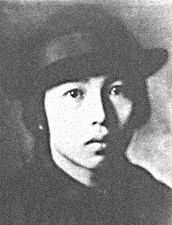Chuya Nakahara
| Nakahara Chūya | |
|---|---|

Nakahara Chūya
|
|
| Born |
29 April 1907 Yamaguchi Japan |
| Died | 22 October 1937 (aged 30) Kanagawa Japan |
| Occupation | Writer |
| Genre | Poetry |
| Literary movement | Dadaism |
Chūya Nakahara (中原 中也 Nakahara Chūya?) (29 April 1907 – 22 October 1937) was a Japanese poet active during the early Shōwa period of Japan.
Nakahara Chūya was born in what is now part of the city of Yamaguchi in Yamaguchi Prefecture in 1907, where his father, Nakahara Kansuke, was a highly decorated army doctor. In his early life, his father was posted to Hiroshima and Kanazawa, returning to Yamaguchi in 1914. In 1915, his younger brother died, and in sorrow he turned to composing poetry. He submitted his first three verses to a women’s magazine and local newspaper in 1920, when he was still in elementary school. In 1923, he moved to the Ritsumeikan Middle School in Kyoto, and from April 1924, began living together with the actress Yasuko Hasegawa.
Initially, Chūya favored poetry in the Japanese traditional tanka format, but he was later (in his teens) attracted to the modern free verse styles advocated by Dadaist poet Takahashi Shinkichi and by Tominaga Tarō.
After he moved to Tokyo, he met Kawakami Tetsutaro and Ooka Shohei, with whom he began publishing a poetry journal, Hakuchigun (Idiots). He was befriended by the influential literary critic Kobayashi Hideo, who introduced him to the French symbolist poets Arthur Rimbaud and Paul Verlaine, whose poems he translated into Japanese. The influence of Rimbaud went beyond just his poetry, and Nakahara came to be known for his "bohemian" lifestyle.
...
Wikipedia
